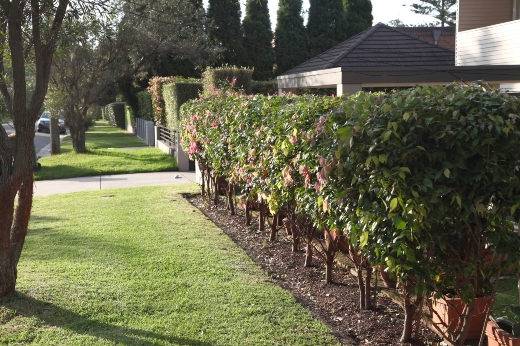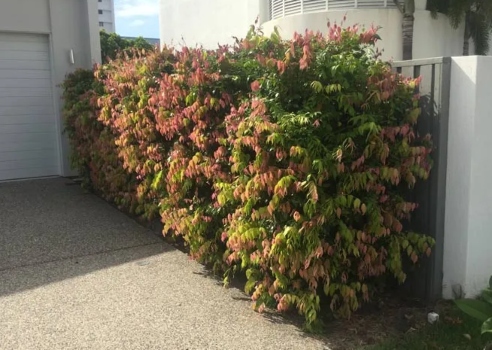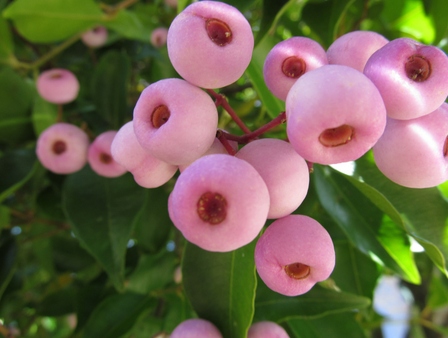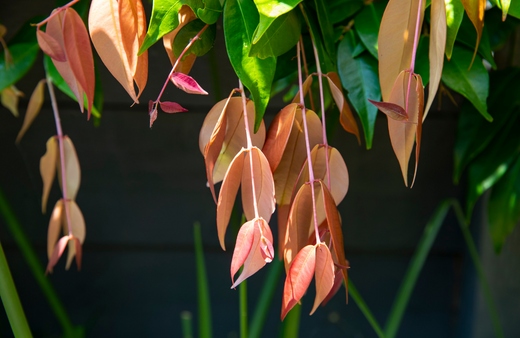Lilly Pilly Cascade is a prized Syzygium hybrid that is highly sought after for not only its tasty fruits but also for its evergreen weeping glossy foliage, spectacular pink powder-puff flowers and its brilliantly bright pink new growth.
Being one of the most ornamental lilly pilly varieties, it’s easy to see why so many Australian gardeners are keen to establish one of their own. Today I will be detailing how you can grow and care for this showy and tasteful native rainforest shrub in your garden.
More...

Source: The Gingerbread House
Family: | Myrtaceae |
|---|---|
Genus: | Syzygium |
Hybrid: | Syzygium luehmannii x Syzygium wilsonii |
Common Names: | Lilly Pilly Cascade |
Location: | Outdoor |
Type: | Shrub |
Growth: | 2 to 4 metres tall, 1 to 3 metres wide |
Sun requirements: | Full sun to half shade |
Foliage Colour: | Green |
Flower Colour: | Pink |
Flowering: | Summer |
Fruit: | Edible pinkish berries in autumn |
Maintenance level: | Low |
Poisonous for pets: | Non-toxic to cats and dogs |
Introducing Lilly Pilly Cascade
The pendulous multi-colour foliage can add a stunning effect in gardens while offering growers a few practical landscaping applications within their outdoor spaces. This medium-sized shrub boasts glossy apple-green leaves that grow almost to the ground with a thick bushy habit.
Enjoy this hardy bush tucker famed for its attractive foliage, showy pink blooms and its edible, decorative fruits.
This cultivar is a hybrid between the already infamous Syzygium luehmannii crossed with the Syzygium wilsonii. The Syzygium genus boasts many fantastic species, most of which are native to our Australian rainforests. This plant forms a part of the Myrtaceae family.
Considered fast-growing in good conditions, lilly pilly cascade will normally reach around 2 to 4 metres tall and 1 to 3 metres wide in cultivation, taking only about 12 weeks to establish itself.
Being a hybrid, this shrub is suitable for most of our endemic climates so it’s a great pick for any gardener looking for a highly attractive and hassle-free lilly pilly. It also features a relatively non-aggressive root system.
Common Landscaping Applications
- Feature specimen
- Topiary plant
- Informal hedging and screening (See our guide on the best Australian native hedge plants)
- Flower gardening
- Native gardening
The berries will attract many local birds, bees, butterflies and other indigenous wildlife. Fruiting will usually occur from year 1 onwards.
Finding Your Syzygium ‘Cascade’
Many local and online Australian nurseries will stock healthy young plants with new roots that will establish quickly in your garden. Because of the hybrid nature of this cultivar, propagation by seed or cuttings is not recommended for a true-to-type specimen.
How to Grow Lilly Pilly Cascade

Source: Hedging and Screening
Best Conditions to Planting Syzygium ‘Cascade’
For the best flowering and fruiting, certain environments will be ideal. Here are the conditions you should aim for when planting and growing your lilly pilly.
Ideal Exposure
This cultivar will perform best in sunny positions in the garden. Full sun to half shade is recommended however in sunnier positions, the plant will maintain a tighter growth habit and better colour overall.


Get Your Free Guide:
Master Growing Australian Natives eBook
A Must Have Complete Guide for Every Australian Garden
Get Your Free Guide:
Master Growing Australian Natives eBook
A Must Have Complete Guide for Every Australian Garden
Best Soil
Lilly pilly cascade along with most other lilly pilly varieties prefers rich, well-draining soil. They can tolerate most soil types so long as drainage and nutrient content is adequate. Sandy, loamy, sandy-loamy or even clay-loam-based soils should work fine.
Dig a little well-composted, organic matter into your soil before planting and your plant will appreciate it. Be sure to avoid overwatering as this plant is very sensitive to wet feet.
Lilly Pilly Cascade Hedge and Screening Tips
Plant 80 cm apart for a fast-forming hedge or screen and plant further apart for a slowing-forming hedge or screen.
Check out our guide on how to grow a lilly pilly hedge for more details.
Planting Lilly Pilly Cascade in Pots
This plant performs equally well in pots. Be sure to use a high-quality potting mix and position your pot in a sunny location in your garden for the best results.
Lilly Pilly Cascade Care Guide
Once established, the shrub will be tolerant to drought and light frosts. Overall, caring for this lilly pilly is far easier than other varieties as it is a robust hybrid bred for an easy gardening experience.
in summer for better moisture retention once established. Regular mulching until established is also recommended. This is usually around 12 weeks.
Source: PlantSelect
Watering Needs
Moderate waterings are recommended as this shrub hates wet feet. Allow the soil to slightly dry out before watering again.
Pruning Lilly Pilly Cascade
Most lilly pillies respond well to pruning and this cultivar is no exception. However, it does require minimal pruning compared to other lilly pillies.
Lightly trim your shrub 2 to 3 times per year to maintain size and keep the growth compact. If you choose, you can even leave it untrimmed and it should still look attractive.
Best Fertiliser
It is best to fertilise your shrub several times per year in the warmer months once established. This will ensure clean and vigorous growth all-round. Feed with an organic native slow-release fertiliser for the best results.
Lilly Pilly Cascade Bush Tucker Guide
This genus has been enjoyed as bush tuckers for many generations. The berries, sometimes referred to as a riberry, have an apple-like texture with a mild sweet taste and a tart undertone in their flavour profiles. Enjoy gourmet bush food with this fantastic cultivar.
The berries will form after flowering in autumn and grow in clusters with firm and shiny skin. They are usually pink to red when ripe but start paler. Traditionally, they were called “medicine berries” believed to help prevent colds and infections.

Pilly Cascade Berries Nutritional Value
- The berries are high in vitamin C
- They contain beneficial antioxidants that help boost the immune system
- They can help to reduce inflammation and boost collagen production in the skin
- More research is required into other possible nutritional benefits
Harvesting Lilly Pilly Cascade Berries
- Berries will ripen a few months after flowering in autumn, usually between December and March.
- They will start pale and turn pink to dark red when ripe and ready for harvest.
- You can pluck the ripened berries straight from the shrub for use.
How to Use Lilly Pilly Berries
- They can be consumed raw straight from the plant after a quick rinse.
- The flesh and skin around the seed can be eaten.
- They can be made into a wide range of sweet and savoury culinary dishes and condiments including but not limited to jams, jellies, sauces, muffins, biscuits and cakes.
- Alternatively, they can be mixed into green salads, blended into smoothies or cooked with sugar to make sweeter dishes.
- The berries pair well with hard cheeses and with meats like kangaroo, pork, poultry and lamb.
- Always rinse the berries before use and keep consumption to a safe quantity when eating any bush food.
Be sure to wait a few weeks after fertilising to pick and use the fruits.
They can be stored in plastic airtight bags for up to 3 weeks in the fridge and up to 2 years in the freezer.
Here are some tasty recipes to help get you started:
Common Lilly Pilly Cascade Pests and Diseases
This fantastic cultivar is extremely resistant to pests and diseases including the dreaded psyllids. In rare situations, they may suffer from mild attacks from scale insects which, if left untreated, could lead to sooty mould.
These sap-sucking insects appear as small circular bumps on the stems and undersides of leaves. They can vary from brown to cottony-white in colour. To treat, simply spray your plant with an organic neem oil spray or similar organic insecticide.
Lilly Pilly Cascade Frequently Asked Questions

What is the lifespan of a lilly pilly?
Approximately 20 years or more.
Do lilly pillies need lots of water?
Established plants shouldn’t need too much watering. On average, it is recommended to water once or twice per week depending on how much sun your plant gets.
Are lilly pillies messy?
Some more vigorous species can become overgrown and messy but usually, the cultivars maintain their neatness quite well. Fallen fruits may become a little inconvenient from time to time.
Looking at establishing other gorgeous lilly pillies? Be sure to check out some of our helpful guides below for more information:
Enjoy Bursts of Lovely Colour and Glossy Foliage with Lilly Pilly Cascade
With so much to offer, it’s easy to see why this lilly pilly cultivar has become so sought-after around the country. With its unmatched beauty in its pink pom-pom blooms and vivid new growth, this shrub can add specular colour and presence to any garden.
Furthermore, the relaxed weeping apple-green foliage can be adored year-round and the tasty and nutritious berries can be used in many exciting ways in the kitchen.
I can’t think of any reason why an avid Australian gardener wouldn’t want this all-around stunning specimen in their gardens so be sure to find your lilly pilly cascade today to start enjoying unparalleled beauty from the Syzygium genus.
Published on November 30, 2022 by Lorri Hopkins
Last Updated on February 22, 2024




